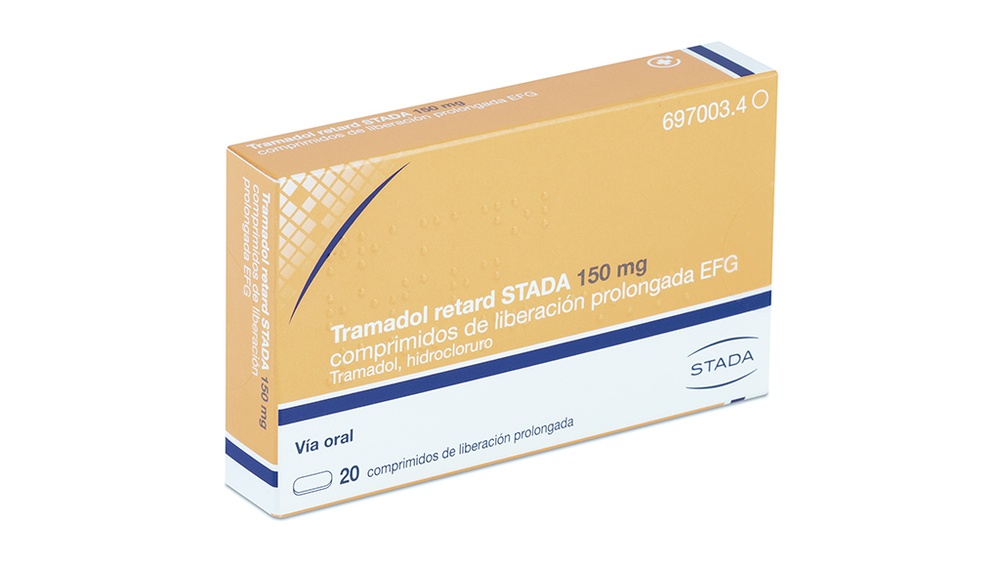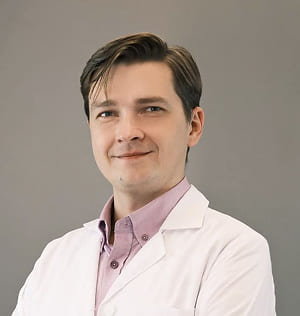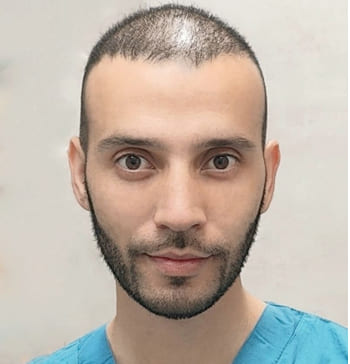

ТРАМАДОЛ РЕТАРД СТАДА 150 мг ТАБЛЕТКИ ПРОДОВЖЕНОЇ ДІЇ

Запитайте лікаря про рецепт на ТРАМАДОЛ РЕТАРД СТАДА 150 мг ТАБЛЕТКИ ПРОДОВЖЕНОЇ ДІЇ

Інструкція із застосування ТРАМАДОЛ РЕТАРД СТАДА 150 мг ТАБЛЕТКИ ПРОДОВЖЕНОЇ ДІЇ
Введення
Опис: інформація для користувача
Трамадол ретард Стада 150 мг пролонговані таблетки
пролонговане виділення
Гідрохлорид трамадолу
Прочитайте уважно весь опис перед початком прийому цього лікарського засобу, оскільки він містить важливу інформацію для вас.
- Збережіть цей опис, оскільки вам може знадобитися знову його прочитати.
- Якщо у вас виникли питання, проконсультуйтеся з вашим лікарем або фармацевтом.
- Цей лікарський засіб призначений тільки для вас, і не слід давати його іншим людям, навіть якщо вони мають相同ні симптоми, оскільки це може їм нашкодити.
- Якщо ви відчуваєте побічні ефекти, проконсультуйтеся з вашим лікарем або фармацевтом, навіть якщо це побічні ефекти, які не наведені в цьому описі. Див. розділ 4.
Зміст опису
- Що таке Трамадол ретард Стада і для чого він використовується
- Що потрібно знати перед початком прийому Трамадол ретард Стада
- Як приймати Трамадол ретард Стада
- Можливі побічні ефекти
- Збереження Трамадол ретард Стада
- Зміст упаковки та додаткова інформація
1. Що таке Трамадол ретард Стада і для чого він використовується
Трамадол - це анальгетик, який належить до групи опіоїдів, що діє на центральну нервову систему. Він полегшує боль, діючи на певні нервові клітини спинного мозку та мозку.
Трамадол ретард використовується для лікування помірного до сильного болю
2. Що потрібно знати перед початком прийому Трамадол ретард Стада
Не приймайте Трамадол ретард Стада
- Якщо ви алергічні на активну речовину або на будь-який інший компонент цього лікарського засобу (перелічені в розділі 6).
- У разі гострих отруєнь, спричинених алкоголем, снодійними засобами, анальгетиками або психотропними засобами (засобами, які діють на настрій і емоції).
- Якщо ви приймаєте інгібітори моноамінооксидази (МАО) (певні лікарські засоби, які використовуються для лікування депресії) або якщо ви приймали їх протягом останніх 14 днів перед початком лікування трамадолом (див. «Інші лікарські засоби та Трамадол ретард Стада»).
- Якщо у вас є епілепсія і ваші конвульсії не контролюються належним чином за допомогою лікування.
- Як лікування синдрому абстиненції.
Попередження та застереження
Проконсультуйтеся з вашим лікарем або фармацевтом перед початком прийому цього лікарського засобу
- Якщо ви думаєте, що маєте залежність від інших анальгетиків (опіоїдів).
- Якщо у вас є порушення свідомості (якщо ви думаєте, що можете втратити свідомість).
- Якщо ви перебуваєте в стані шоку (одним із ознак цього стану може бути холодний пот).
- Якщо у вас підвищений тиск всередині черепа (наприклад, після травми голови або захворювання мозку).
- Якщо у вас є труднощі з диханням.
- Якщо ви епілептик або маєте конвульсії, оскільки ризик цих конвульсій може збільшитися.
- Якщо у вас є захворювання печінки або нирок.
- Якщо ви страждаєте на депресію і приймаєте антидепресанти, оскільки деякі з них можуть взаємодіяти з трамадолом (див. «Інші лікарські засоби та Трамадол ретард Стада»).
У таких випадках, будь ласка, проконсультуйтеся з вашим лікарем перед прийомом лікарського засобу.
Зареєстровані випадки епілептичних конвульсій у пацієнтів, які приймали трамадол у рекомендованій дозі. Ризик може збільшитися, коли доза трамадолу перевищує рекомендовану добову дозу (400 мг).
Толерантність, залежність і звичка
Цей лікарський засіб містить трамадол, який є опіоїдним лікарським засобом. Повторне використання опіоїдів може зробити лікарський засіб менш ефективним (організм звикає до нього, що відомо як фармакологічна толерантність). Повторне використання трамадолу також може спричинити залежність, зловживання та звичку, що може привести до потенційно смертельної передозування. Ризик цих побічних ефектів може бути більшим при вищій дозі та тривалому застосуванні.
Залежність або звичка можуть спричинити відчуття відсутності контролю над кількістю лікарського засобу, який потрібно приймати, або над частотою прийому.
Ризик залежності або звички варіюється від особи до особи. Ризик стати залежним
або звикнути до трамадолу може бути більшим, якщо:
- Ви або будь-хто з вашої родини мали проблеми з алкоголем або залежністю від лікарських засобів з рецептом або заборонених речовин («залежність»).
- Ви курите.
- Ви мали проблеми з настроєм (депресія, тривога або розлад особистості) або проходили лікування у психіатра за інші психічні захворювання.
- Якщо ви спостерігаєте будь-які з наступних симптомів під час прийому трамадолу, це може бути ознакою залежності або звички:
- Вам потрібно приймати лікарський засіб триваліший час, ніж вказано вашим лікарем.
- Вам потрібно приймати вищу дозу, ніж рекомендовано.
- Ви використовуєте лікарський засіб за іншими причинами, ніж ті, які призначені, наприклад, «щоб бути спокійним» або «щоб допомогти заснути».
- Ви зробили повторні спроби припинити прийом лікарського засобу або контролювати його використання, але вони були невдалими.
- Ви відчуваєте себе погано, коли припиняєте прийом лікарського засобу, і відчуваєте себе краще, коли знову починаєте його приймати («ефекти відміни»).
Якщо ви помітили будь-які з цих ознак, проконсультуйтеся з вашим лікарем, щоб визначити найкращий варіант лікування для вас, коли потрібно припинити прийом лікарського засобу і як це зробити безпечно (див. розділ 3, якщо ви припиняєте лікування трамадолом).
Трамадол перетворюється в печінці за допомогою ферменту. Деякі люди мають варіацію цього ферменту, і це може вплинути на кожного по-різному. У деяких людей може не бути достатнього полегшення болю, тоді як інші люди мають більший ризик серйозних побічних ефектів. Якщо ви помітили будь-які з наступних побічних ефектів, вам потрібно припинити прийом цього лікарського засобу і негайно проконсультуватися з лікарем: повільне або поверхневе дихання, сплутаність свідомості, сонливість, звуження зіниць, загальне нездоров'я або нудота, запор, відсутність апетиту.
Розлади дихання, пов'язані зі сном
Трамадол може спричинити розлади дихання, пов'язані зі сном, такі як апное сну (паузи в диханні під час сну) та гіпоксемія, пов'язана зі сном (низький рівень кисню в крові). Серед симптомів можуть бути паузи в диханні під час сну, нічні пробудження через нестачу повітря, труднощі з підтриманням сну або надмірна сонливість вдень. Якщо ви або хтось інший спостерігає ці симптоми, зверніться до вашого лікаря. Можливо, ваш лікар розгляне питання про зниження дози.
Поговоріть з вашим лікарем, фармацевтом або медсестрою, якщо ви відчуваєте будь-які з наступних симптомів під час прийому трамадолу:
Надмірна втома, відсутність апетиту, сильний біль у животі, нудота, блювота або низький тиск. Це можуть бути ознаки недостатньої функції наднирників (низький рівень кортизолу). Якщо ви маєте ці симптоми, зверніться до вашого лікаря, який вирішить, чи потрібно вам приймати гормональні добавки.
Існує ризик розвитку серотонінового синдрому, який може виникнути після прийому трамадолу в поєднанні з певними антидепресантами або трамадолом у монотерапії. Негайно зверніться до лікаря, якщо ви спостерігаєте будь-які з симптомів, пов'язаних з цим серйозним синдромом (див. розділ 4 «Можливі побічні ефекти»).
Діти
Цей лікарський засіб не підходить для дітей молодших 12 років.
Використання в дітей з проблемами дихання
Не рекомендується використовувати трамадол у дітей з проблемами дихання, оскільки симптоми токсичності трамадолу можуть погіршитися в цих дітей.
Інші лікарські засоби та Трамадол ретард Стада
Повідомте вашому лікареві або фармацевту, якщо ви приймаєте, нещодавно приймали або можете приймати будь-які інші лікарські засоби.
Не слід проводити одночасне лікування трамадолом та інгібіторами моноамінооксидази (МАО) (лікарські засоби для лікування депресії).
Анальгетичний ефект трамадолу, а також тривалість його дії, можуть зменшитися, якщо ви приймаєте лікарські засоби, які містять:
- Карбамазепін (для лікування епілепсії)
- Пентазоцин, налбуфін або бупренорфін (анальгетики);
- Ондансетрон (лікарський засіб для профілактики нудоти)
Ваш лікар призначить вам прийом трамадолу та його дозу. Ризик побічних ефектів збільшується,
- Якщо ви приймаєте снодійні засоби, засоби, які викликають сон, інші анальгетики, такі як морфін і кодеїн (також при кашлі), та алкоголь під час прийому трамадолу. Це може спричинити надмірну сонливість або відчуття передчуття втрати свідомості. Якщо це відбувається, зверніться до вашого лікаря.
- Якщо ви приймаєте лікарські засоби, які можуть спричинити конвульсії, такі як деякі антидепресанти або антипсихотичні засоби. Ризик конвульсій може збільшитися, якщо ви приймаєте трамадол одночасно. Ваш лікар вирішить, чи підходить трамадол для вас.
- Якщо ви приймаєте антидепресанти, трамадол може взаємодіяти з цими лікарськими засобами та спричинити серотоніновий синдром (див. розділ 4 «Можливі побічні ефекти»).
- Якщо ви приймаєте антикоагулянти-кумарини (лікарські засоби, які запобігають ненормальному згортанню крові), такі як варфарин, разом з трамадолом. Ефект цих лікарських засобів на згортання крові може змінитися та призвести до кровотечі.
- Одночасне використання трамадолу з снодійними засобами, такими як бензодіазепіни або пов'язані з ними лікарські засоби, збільшує ризик седації, депресії дихання, коми або навіть смерті. Через це одночасне використання повинно розглядатися лише тоді, коли немає інших варіантів лікування. Однак, якщо ваш лікар призначає вам трамадол ретард разом з снодійними засобами, доза та тривалість лікування повинні бути обмежені вашим лікарем.
Повідомте вашому лікареві про всі снодійні лікарські засоби, які ви приймаєте, та слідкуйте за рекомендаціями щодо дозування, які дає ваш лікар. Це може бути корисно повідомити друзям або родичам, щоб вони знали про ознаки та симптоми, зазначені вище. Зверніться до вашого лікаря, якщо ви спостерігаєте ці симптоми.
- Якщо ви приймаєте габапентин або прегабалін для лікування епілепсії або болю, пов'язаного з проблемами нервів (нейропатичний біль)
Прийом Трамадол ретард Стада з їжею, напоями та алкоголем
Не вживайте алкоголь під час лікування трамадолом, оскільки його ефект може посилитися. Їжа не впливає на ефект цього лікарського засобу.
Вагітність та годування грудьми
Якщо ви вагітні або годуєте грудьми, вважаєте, що можете бути вагітною або плануєте завагітніти, проконсультуйтеся з вашим лікарем або фармацевтом перед прийомом цього лікарського засобу.
Є дуже мало інформації про безпеку трамадолу під час вагітності людини. Тому не слід приймати цей лікарський засіб, якщо ви вагітні.
Тривале використання під час вагітності може призвести до синдрому абстиненції у новонароджених.
Трамадол виділяється в грудне молоко. Через це не слід приймати цей лікарський засіб більше одного разу під час годування грудьми, або якщо ви приймаєте трамадол більше одного разу, вам потрібно припинити годування грудьми.
Водіння транспортних засобів та використання машин
Спитайте в вашого лікаря, чи можете ви водити транспортні засоби або використовувати машини під час лікування трамадолом. Це важливо, щоб спостерігати, як цей лікарський засіб впливає на вас. Не водьте транспортні засоби та не використовуйте машини, якщо ви відчуваєте сонливість, головокружіння, маєте розмитий зір або бачите подвійне, або маєте труднощі з концентрацією уваги. Будьте особливо обережні на початку лікування, після збільшення дози, після зміни форми випуску та/або при прийомі разом з іншими лікарськими засобами.
3. Як приймати Трамадол ретард Стада
Слідуйте точно інструкціям щодо прийому цього лікарського засобу, які вказані вашим лікарем. У разі сумнівів проконсультуйтеся з вашим лікарем або фармацевтом.
Перед початком лікування та регулярно під час нього ваш лікар також пояснить, чого можна очікувати від використання трамадолу, коли та протягом якого часу потрібно його приймати, коли потрібно звернутися до лікаря та коли потрібно припинити прийом (див. також розділ 2).
Дозу потрібно调整 до інтенсивності болю та індивідуальної чутливості до болю. Зазвичай потрібно приймати найменшу анальгетичну дозу, яка забезпечує полегшення болю.
Якщо ваш лікар не дав вам інших інструкцій, рекомендована доза становить:
Дорослі та підлітки старші 12 років
Одна таблетка Трамадол ретард Стада 150 мг пролонговані таблетки з виділенням двічі на добу (що еквівалентно 300 мг гідрохлориду трамадолу на добу), бажано вранці та ввечері.
Якщо потрібно, ваш лікар може призначити вам іншу, більш підходящу дозу цього лікарського засобу.
Якщо потрібно, дозу можна збільшити до 200 мг двічі на добу (що еквівалентно 400 мг гідрохлориду трамадолу на добу).
Не приймайте більше 400 мг гідрохлориду трамадолу на добу, якщо ваш лікар не вказав інше.
Пацієнти похилого віку
У пацієнтів похилого віку (старших 75 років) виділення трамадолу може бути повільним. Якщо це ваш випадок, ваш лікар може збільшити інтервал між прийомами.
Пацієнти з порушеннями функції печінки або нирок/гемодіаліз
Якщо у вас є серйозне захворювання печінки або нирок, не слід приймати цей лікарський засіб. Якщо у вас є легкі або помірні порушення, ваш лікар може збільшити інтервал між прийомами.
Як і коли приймати Трамадол ретард Стада?
Цей лікарський засіб приймається перорально.
Завжди потрібно ковтати таблетки цілими, не дроблячи та не жуючись, з достатньою кількістю рідини, бажано вранці та ввечері. Ви можете приймати таблетку з пустим шлунком або з їжею.
Як довго потрібно приймати Трамадол ретард Стада?
Цей лікарський засіб не повинен прийматися довше, ніж абсолютно необхідно.
Якщо вам потрібно тривале лікування, ваш лікар буде контролювати вас на коротких інтервалах та регулярно (якщо потрібно, з перервами в лікуванні) щодо того, чи потрібно продовжувати лікування Трамадолом та якою дозою.
Якщо ви вважаєте, що дія цього лікарського засобу надто сильна або слабка, повідомте вашому лікареві або фармацевту.
Використання в дітей
Цей лікарський засіб не підходить для дітей молодших 12 років.
Якщо ви прийняли більше Трамадол ретард Стада, ніж потрібно
Якщо ви прийняли помилково більше трамадолу, ніж потрібно, зазвичай це не призведе до негативних ефектів. Ви повинні прийняти наступну дозу, як було призначено.
Після прийому дуже високих доз може виникнути звуження зіниць, блювота, зниження артеріального тиску, збільшення частоти серцевих скорочень, колапс, зниження рівня свідомості до коми (глибока безсвідомість), епілептичні конвульсії та труднощі з диханням, які можуть призвести до зупинки дихання. У такому випадку негайно зверніться до лікаря.
У разі передозування або випадкового прийому зверніться негайно до вашого лікаря, фармацевта або телефонуйте в Токсикологічну службу, телефон 91.562.04.20, вказуючи лікарський засіб та кількість, прийняту.
Якщо ви забули прийняти Трамадол ретард Стада
Якщо ви забули прийняти таблетки, ймовірно, біль знову проявиться. Не приймайте подвійну дозу, щоб компенсувати забуті дози, просто продовжуйте лікування згідно з інструкціями вашого лікаря.
Якщо ви припиняєте лікування Трамадол ретард Стада
Якщо ви припиняєте лікування Трамадол ретард Стада занадто рано, ймовірно, біль знову проявиться. Якщо ви хочете припинити лікування через побічні ефекти, проконсультуйтеся з вашим лікарем.
Зазвичай не спостерігаються побічні ефекти при закінченні лікування трамадолом. Однак у рідких випадках, коли деякі люди, які приймали трамадол протягом деякого часу, раптово припиняють його прийом, вони можуть відчувати себе погано. Вони можуть відчувати агресивність, тривогу, нервозність або тремор. Вони можуть відчувати гіперактивність, мати труднощі з сном або розлади шлунково-кишкового тракту. Дуже рідко люди можуть відчувати панічні атаки, галюцинації, незвичайні відчуття, такі як печія, оніміння та звуження, і звук у вухах (акуфени). Рідко спостерігаються інші незвичайні симптоми центральної нервової системи, такі як сплутаність свідомості, марення, спотворення сприйняття власної особистості (деперсоналізація) та порушення сприйняття реальності (дереалізація) та марення переслідування (параноя). Якщо ви спостерігаєте будь-які з цих симптомів після припинення прийому трамадолу, проконсультуйтеся з вашим лікарем.
Якщо у вас є будь-які питання щодо використання цього лікарського засобу, проконсультуйтеся з вашим лікарем або фармацевтом
4. Можливі побічні ефекти
Як і всі лікарські засоби, трамадол може мати побічні ефекти, хоча не всі люди їх відчувають. Зазвичай частота побічних ефектів класифікується наступним чином:
- Дуже часті (можуть впливати на більше 1 з 10 осіб)
- Часті (можуть впливати до 1 з 10 осіб) - Рідкі (можуть впливати до 1 з 100 осіб)
- Рідкісні (можуть впливати 1 з 1000 осіб)
- Дуже рідкісні (можуть впливати 1 з 10 000 осіб)
- Частота невідома (не може бути оцінена з наявних даних)
Ви повинні звернутися до лікаря негайно, якщо ви відчуваєте симптоми алергічної реакції, такі як набряк обличчя, язика та/або горла і/або труднощі з ковтанням та висипка разом з труднощами з диханням. Найбільш часті побічні ефекти під час лікування трамадолом ретард є нудота та головокружіння, які виникають у більше 1 з 10 пацієнтів.
Розлади метаболізму та харчування
Частота невідома: Зниження рівня цукру в крові.
Розлади серцево-судинної системи:
Рідкі: Ефекти на серце та кровообіг (сильні та швидкі удари серця, знеболювання або колапс). Ці побічні ефекти можуть виникнути особливо у пацієнтів, які знаходяться в положенні лежачи або які здійснюють фізичні зусилля.
Рідкісні: Повільний удар серця, підвищення артеріального тиску.
Розлади нервової системи
Дуже часті: Головокружіння.
Часті: Головні болі, сонливість.
Рідкісні: Зміни в апетиті, незвичайні відчуття (наприклад, свербіж, оніміння та поколювання), тремор, повільне дихання, епілептичні напади, м'язові спазми, некоординовані рухи, тимчасова втрата свідомості (синкоп). Якщо ви перевищуєте рекомендовані дози або якщо ви приймаєте інші лікарські засоби, які пригнічують функцію мозку, дихання може уповільнитися. Епілептичні напади можуть виникнути переважно після прийому високих доз трамадолу або коли ви приймаєте лікарські засоби, які можуть викликати епілептичні напади.
Частота невідома: Розлади мови.
Психіатричні розлади
Рідкісні: Галюцинації, сплутаність свідомості, порушення сну, тривога та кошмари. Психологічні проблеми можуть виникнути після лікування трамадолом. Їх інтенсивність та характер можуть варіюватися (залежно від особистості пацієнта та тривалості лікування). Ці проблеми можуть проявлятися як зміна настрою (зазвичай надмірна доброзичливість, іноді гнів), зміни в діяльності (зазвичай пригнічення, іноді підвищення) та зниження когнітивної та сенсорної сприйняття (зміни в відчуттях та сприйнятті, які можуть привести до помилок у судженні). Можлива залежність.
Очні розлади
Рідкісні: Затьмарене зір.
Частота невідома: Надмірне розширення зіниць (мідріаз).
Дихальні, грудні та медіастинальні розладиРідкісні: Недостатність дихання (диспное). Відомо про погіршення бронхіальної астми, однак не встановлено причинно-наслідкової зв'язку з трамадолом.
Частота невідома: Ікота
Розлади травлення
Дуже часті: Нудота.
Часті: Вомітування, запор, сухість у роті. Р
ідкісні: Регургитація, проблеми з шлунком (наприклад, відчуття тиску в шлунку, набряк), діарея.
Шкірні розлади
Часті: Пітливість.
Рідкісні: Реакції шкіри (наприклад, свербіж, висипка).
М'язові розлади
Рідкісні: М'язова слабкість.
Розлади печінки та жовчних шляхів
Дуже рідкісні: Збільшення рівня печінкових ферментів.
Сечові розлади
Рідкісні: Труднощі або біль при сечовипусканні, менша кількість сечі, ніж зазвичай.
Загальні розлади
Часті: Втома.
Рідкісні: У дуже рідкісних випадках повідомлялося про алергічні реакції (наприклад, труднощі з диханням, свист, набряк шкіри) та шок (наглий колапс кровообігу). Якщо ви приймаєте трамадол протягом тривалого періоду, може виникнути залежність, хоча ризик дуже низький. Коли лікування раптово припиняється, можуть виникнути симптоми абстиненції (див. "Якщо ви припиняєте прийом Трамадол ретард Стада ").
Якщо ви вважаєте, що будь-який з побічних ефектів, які ви відчуваєте, є серйозним або якщо ви помітили будь-який побічний ефект, не згаданий у цій брошурі, повідомте про це своєму лікареві або фармацевту.
Частота невідома (не може бути оцінена з наявних даних)
Серотоніновий синдром, який може проявлятися через зміни психічного стану (наприклад, агітацію, галюцинації, кому), та інші ефекти, такі як підвищення температури тіла, збільшення частоти серцевих скорочень, нестабільний артеріальний тиск, м'язові спазми, м'язова ригідність, порушення координації та/або шлунково-кишкові симптоми (наприклад, нудота, вомітування, діарея) (див. розділ 2 "Що вам потрібно знати перед початком прийому Трамадол ретард Стада").
Повідомлення про побічні ефекти:
Якщо ви відчуваєте будь-який побічний ефект, зверніться до свого лікаря або фармацевта, навіть якщо це можливі побічні ефекти, які не вказані в цій брошурі. Ви також можете повідомити про них безпосередньо через Іспанську систему моніторингу лікарських засобів для людини: https://www.notificaram.es. Завдяки повідомленню про побічні ефекти ви можете допомогти надати більше інформації про безпеку цього лікарського засобу.
5. Зберігання Трамадол ретард Стада
Тримати поза зоною видимості та доступу дітей.
Зберігайте цей лікарський засіб у безпечному місці, захищеному від доступу інших осіб. Цей лікарський засіб може викликати серйозні ушкодження та навіть бути смертельним для осіб, яким він не призначений.
Цьому лікарському засобу не потрібні спеціальні умови зберігання.
Не використовуйте цей лікарський засіб після закінчення терміну його дії, вказаного на коробці та блистерній упаковці після "EXP". Термін дії закінчується в останній день місяця, вказаного на упаковці.
Лікарські засоби не повинні викидатися у водопровідні труби чи сміття. Віднесіть упаковку та лікарські засоби, які вам не потрібні, до пункту збору фармацевтичного сміття в аптеці. У разі сумнівів запитайте у свого фармацевта, як позбутися упаковки та лікарських засобів, які вам не потрібні. Таким чином, ви допоможете захистити навколишнє середовище.
6. Зміст упаковки та додаткова інформація
Склад Трамадол ретард Стада
Активним інгредієнтом є гідрохлорид трамадолу. Кожна таблетка містить 150 мг гідрохлориду трамадолу.
Інші складові частини: Гідрогенфосфат кальцію дигідрат (Е341), Гідроксипропілцелюлоза (Е463), Колоїдна кремнеземна діоксид (Е551), Стеарат магнію (Е470b)
Вигляд продукту та вміст упаковки
Трамадол ретард Стада 150 мг таблетки з пролонгованим вивільненням є білими таблетками капсульної форми.
Варіанти упаковки:
Блістерна упаковка: 20 та 60 таблеток
Власник авторизації на торгівлю та відповідальна особа за виробництво
Власник авторизації на торгівлю
Лабораторія STADA, S.L.
Фредерік Момпу, 5
08960 Сант Жуст Десверн (Барселона)
Іспанія
Відповідальна особа за виробництво
Фармацевтична аналітична лабораторія Дуйвен Б.В (FAL Duiven B.V)
Дейкграаф 30, 6921 РЛ, Дуйвен
Нідерланди
О
Медохемі Ltd (Фабрика AZ)
2 Міхаеля Ераклеуса вулиця, Агіос Афанасіос Промислова зона, Лімасол, 4101
Кіпр
Ця брошура була затверджена в травні 2024 року
Детальна та актуальна інформація про цей лікарський засіб доступна на сайті Іспанського агентства лікарських засобів та медичних продуктів (AEMPS) http://www.aemps.es/

Скільки коштує ТРАМАДОЛ РЕТАРД СТАДА 150 мг ТАБЛЕТКИ ПРОДОВЖЕНОЇ ДІЇ в Іспанії у 2025 році?
ТРАМАДОЛ РЕТАРД СТАДА 150 мг ТАБЛЕТКИ ПРОДОВЖЕНОЇ ДІЇ коштує в середньому 6.21 євро у грудень, 2025 році. Ціна може змінюватися залежно від регіону, аптеки та наявності рецепта. Рекомендуємо перевіряти актуальну вартість у місцевих аптеках або через онлайн-сервіси.
- Країна реєстрації
- Середня ціна в аптеках6.21 EUR
- Діючі речовини
- Потрібен рецептТак
- Виробник
- Інформація є довідковою і не є медичною порадою. Перед прийомом будь-яких препаратів обов'язково проконсультуйтеся з лікарем. Oladoctor не несе відповідальності за медичні рішення, прийняті на основі цього контенту.
- Альтернативи до ТРАМАДОЛ РЕТАРД СТАДА 150 мг ТАБЛЕТКИ ПРОДОВЖЕНОЇ ДІЇФорма випуску: ОРАЛЬНИЙ РОЗЧИН/СУСПЕНЗІЯ, 100 мг/млДіючі речовини: tramadolВиробник: Grünenthal Pharma S.A.Потрібен рецептФорма випуску: РОЗЧИН ДЛЯ ІН'ЄКЦІЙ, 100 мгДіючі речовини: tramadolВиробник: Grünenthal Pharma S.A.Потрібен рецептФорма випуску: КАПСУЛА, 50 мгДіючі речовини: tramadolВиробник: Grünenthal Pharma S.A.Потрібен рецепт
Аналоги ТРАМАДОЛ РЕТАРД СТАДА 150 мг ТАБЛЕТКИ ПРОДОВЖЕНОЇ ДІЇ в інших країнах
Найкращі аналоги з тією самою діючою речовиною та терапевтичним ефектом.
Аналог ТРАМАДОЛ РЕТАРД СТАДА 150 мг ТАБЛЕТКИ ПРОДОВЖЕНОЇ ДІЇ у Польща
Аналог ТРАМАДОЛ РЕТАРД СТАДА 150 мг ТАБЛЕТКИ ПРОДОВЖЕНОЇ ДІЇ у Україна
Лікарі онлайн щодо ТРАМАДОЛ РЕТАРД СТАДА 150 мг ТАБЛЕТКИ ПРОДОВЖЕНОЇ ДІЇ
Консультація щодо дозування, побічних ефектів, взаємодій, протипоказань та поновлення рецепта на ТРАМАДОЛ РЕТАРД СТАДА 150 мг ТАБЛЕТКИ ПРОДОВЖЕНОЇ ДІЇ – за рішенням лікаря та згідно з місцевими правилами.














